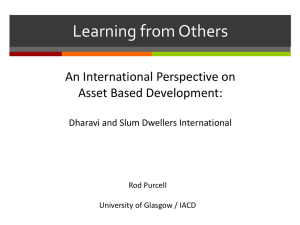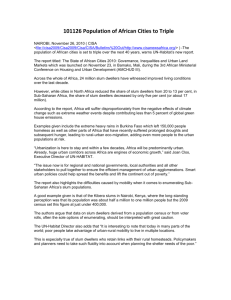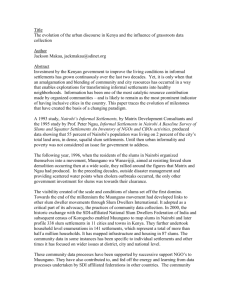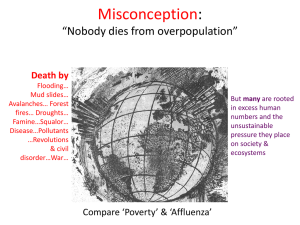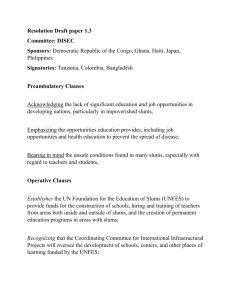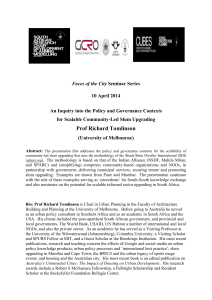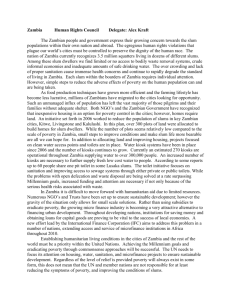Cooperatives for improving living conditions in Slums
advertisement
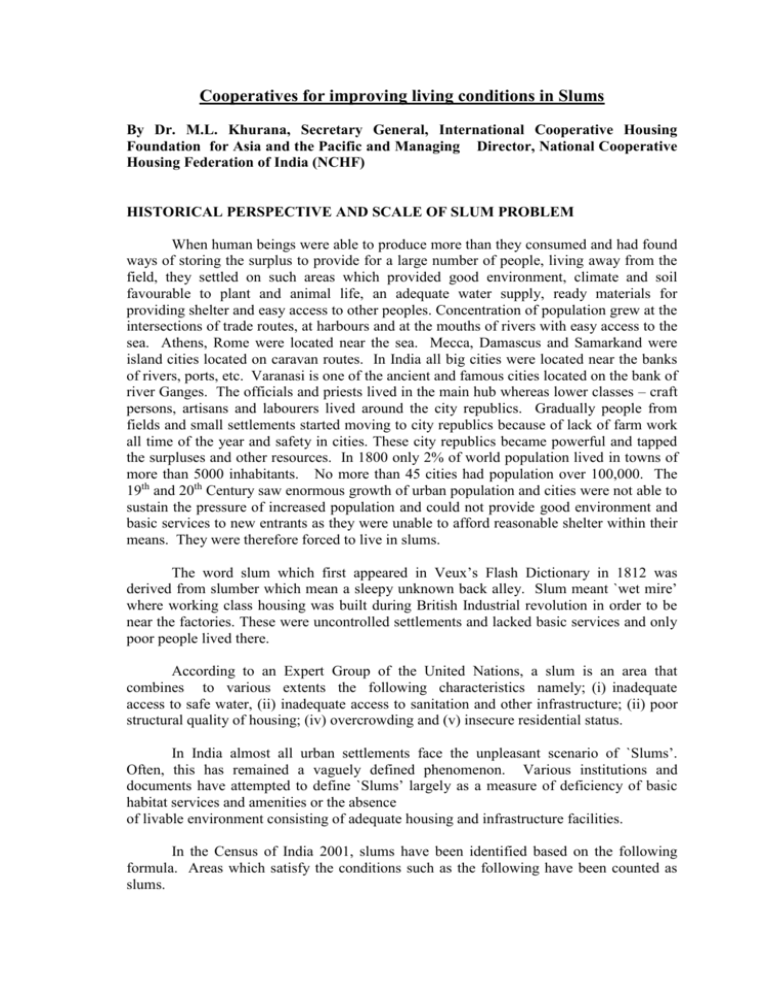
Cooperatives for improving living conditions in Slums By Dr. M.L. Khurana, Secretary General, International Cooperative Housing Foundation for Asia and the Pacific and Managing Director, National Cooperative Housing Federation of India (NCHF) HISTORICAL PERSPECTIVE AND SCALE OF SLUM PROBLEM When human beings were able to produce more than they consumed and had found ways of storing the surplus to provide for a large number of people, living away from the field, they settled on such areas which provided good environment, climate and soil favourable to plant and animal life, an adequate water supply, ready materials for providing shelter and easy access to other peoples. Concentration of population grew at the intersections of trade routes, at harbours and at the mouths of rivers with easy access to the sea. Athens, Rome were located near the sea. Mecca, Damascus and Samarkand were island cities located on caravan routes. In India all big cities were located near the banks of rivers, ports, etc. Varanasi is one of the ancient and famous cities located on the bank of river Ganges. The officials and priests lived in the main hub whereas lower classes – craft persons, artisans and labourers lived around the city republics. Gradually people from fields and small settlements started moving to city republics because of lack of farm work all time of the year and safety in cities. These city republics became powerful and tapped the surpluses and other resources. In 1800 only 2% of world population lived in towns of more than 5000 inhabitants. No more than 45 cities had population over 100,000. The 19th and 20th Century saw enormous growth of urban population and cities were not able to sustain the pressure of increased population and could not provide good environment and basic services to new entrants as they were unable to afford reasonable shelter within their means. They were therefore forced to live in slums. The word slum which first appeared in Veux’s Flash Dictionary in 1812 was derived from slumber which mean a sleepy unknown back alley. Slum meant `wet mire’ where working class housing was built during British Industrial revolution in order to be near the factories. These were uncontrolled settlements and lacked basic services and only poor people lived there. According to an Expert Group of the United Nations, a slum is an area that combines to various extents the following characteristics namely; (i) inadequate access to safe water, (ii) inadequate access to sanitation and other infrastructure; (ii) poor structural quality of housing; (iv) overcrowding and (v) insecure residential status. In India almost all urban settlements face the unpleasant scenario of `Slums’. Often, this has remained a vaguely defined phenomenon. Various institutions and documents have attempted to define `Slums’ largely as a measure of deficiency of basic habitat services and amenities or the absence of livable environment consisting of adequate housing and infrastructure facilities. In the Census of India 2001, slums have been identified based on the following formula. Areas which satisfy the conditions such as the following have been counted as slums. (i) (ii) (iii) Towns and cities with population of 50,000 and above as per 1991 Census; and Areas notified as slums by the State or Local Body; or A compact area of at least 300 persons or 60-70 households living in poorly built congested tenements in unhygienic environment usually with inadequate infrastructure and lacking in proper sanitary and drinking water facilities. The recent HABITAT report on slums says that in 2001 a total of 923,986,00 people constituting about 31.6 per cent of the world’s total urban population were living in slums. Nearly 43% of the urban population of all the developing regions combined live in slums, 78.2% of the urban population in the Least Developed Countries live in slums; about 6% of the urban population in Developed regions live in slum-like conditions. On the present trends, 2 billion people would be living in slums by 2030. This is because of enormous migration from rural to urban areas, new family formation and increase of population. Census of India 2001, has found that 607 towns spread among 26 States and Union Territories are reporting slum population in their areas. Their total slum population is 40.3 million comprising 21.5 million males and 18.8 million females. Maharashtra topped with over 10 million slum dwellers, Andhra Pradesh has about 5 million, Uttar Pradesh and West Bengal towns hold slum population of 4 million each. An information of grave concern is that the slum population of 40 million also include over 5.5 million infants and children in the age group of 0-6 years. Indeed, it is unfortunate that such large number of children are also doomed to suffer the social deprivations of slums. More than 41% of Kolkata’s slum households have lived in slums for more than 30 years. Our country, therefore, can ill-afford to neglect the welfare of such large number of its citizens. Adequately catering to their socio-economic development needs should engage our immediate attention in larger interest of national development and national integration. LIVING CONDITIONS IN SLUMS Almost all the houses in slums are in bad, and sometimes dilapidated, conditions. The houses are usually inadequately ventilated. The designs are such as to afford bare shelter, leading to acute congestion. In squatter settlements, houses are constructed using materials like mud, un-burnt bricks, tin-sheets, asbestos sheets, bamboo, gunny bags, plastic sheets etc. and are usually single-room units with inadequate space standards. Private toilets do not exist in a majority of slum areas and even common toilets are available only in a few. Where there are no toilets, people defecate in the open which, besides being an environmental nuisance, poses hardships for, especially women. Community latrines, even where available generally remain filthy and insanitary and virtually a menace to the areas in which they exist. Most of the houses in slum areas do not have individual water supply. In some slum areas, public taps do exist but the number of persons using each such tap is generally very high. Many slums, especially in the outskirts of the cities, have open wells as their only source of water for drinking, bathing and cleaning. These wells are generally 2 insanitary. No attention is paid to the maintenance of wells, or even of public taps. A considerable number of slum dwellers have to fetch water from outside the slum areas. The drainage system in almost all the slums is very poor. With the exception of pucca buildings in old city areas, slum settlements generally do not have any drainage. Further more, a majority of unauthorised colonies and squatter settlements are located on low-lying lands. As a result, sullage water cannot flow away. The situation becomes particularly worse during the rainy season when storm water finds its way into these low lying settlements and get mixed-up with the sullage water, making extremely unhygienic environment. Roads and lanes are narrow and often unpaved. Puddles and slush are commonplace after every rain shower. The facility of roads and street lights is generally inadequate. This adversely affects the safety and security of residents and is generally believed to be largely responsible for high rates of night-time crimes. There is a complex relationship between environment and health. A number of studies have shown that the unhygienic slum environments make slum dwellers more susceptible to certain types of diseases like respiratory diseases, gastro-intestinal disorders, skin diseases, malarial fever, tuberculosis, etc. Unfortunately, the economic circumstances of the slum dwellers are such as they do not allow them to improve their living conditions. A majority of the sum dwellers are employed in the unorganised or informal sector. A large proportion of them work on a daily wage basis and, therefore, have little or no job security. A significant proportion is employed in construction work. Due to low income, their standard of living is also low and they are left with little surplus income for housing after meeting their families basic needs of food and clothing. In brief we may say that slum dwellers are faced with insecurity of tenure, lack of basic services, especially water and sanitation, unsafe building structure, over-crowding, limited access to credit and formal job markets. Normally slums exist on polluted land. They suffer from water-borne diseases. It is also believed that slums are places of high level of crimes. This is not universally true. The poverty is the main reason for slums. At the same time slums also provide low cost accommodation to poor migrants and necessary support to city. SLUM PROBLEM AND GOVERNMENT INTERVENTION The Government of India has taken certain initiatives for the development of infrastructure as well as improvement of environment in urban settlements with a view to improving the quality of life. In this context, the Ministry of Urban Development and Poverty Alleviation are monitoring the implementation of a few Centrally Sponsored Schemes for which, besides policy guidelines, State Governments and their development agencies are given financial support in the form of grants and loans. Some such schemes relate to the development of infrastructure in Mega Cities where infrastructure projects related to water supply and sewerage, roads and bridges, city transport, solid waste management, etc. are implemented on sustainable basis with appropriate direct and indirect cost recovery measures. The National Slum Development 3 Programme is another scheme launched in 1996 where additional central assistance is granted for the development of urban slums. The objective of this programme is upgradation of urban slums by providing physical amenities like water supply, storm water drains, community baths, widening and paving of existing lanes, sewers, community latrines, street light etc. Community infrastructure and social amenities such as pre-school education, non-formal education, adult education, maternity and child health care including immunization as well as shelter up-gradation or construction of new houses are also part of this scheme. The Valmiki Ambedkar Awas Yojana (VAMBAY) : The Central Government scheme has the primary objective to facilitate the construction and upgradation of the dwelling units for the slum dwellers and to provide health and enabling urban environment through community toilets under Nirmal Bharat Abhiyan, a component of the scheme. This is the first scheme of its kind meant exclusively for slum dwellers with a Government of India subsidy of 50 percent. The balance 50 percent is to be arranged by State Government with ceiling costs prescribed both for dwelling units/community toilets. During the financial year 2002-03, central subsidy to the extent of Rs.218.35 crores for the construction of 110388 dwelling units and 21488 toilet seats was released. So far a total of 2.08 lakh dwelling units covering 20 States and Union Territories have been sanctioned under VAMBAY. ROLE OF NGOs The emerging scenario of the complex socio-economic problems of slum dwellers and the somewhat isolated, piece-meal action plans and programmes drawn up so far by the Governments amply has not effectively hit the target. Thus while on the one hand the slum population is growing and the slum conditions are worsening, on the other hand, the slum programmes usually remain only partly accomplished. What is needed is Peoples’ Participation, both in policy formulation and implementation of programmes. In this regard, Non-Governmental Organisations (NGOs) with their local knowledge, skill and practical experience can play very effective role in programmes for improving living and economic conditions of slum dwellers. Various Five Year Plan documents have explicitly recognised the importance of involving NGOs in the planning and implementation of anti-poverty and minimum needs programme, which includes environmental improvement of slum areas only. ROLE OF COOPERATIVES IN SLUM IMPROVEMENT The essence of cooperation is that individuals come together to achieve as a collective what they cannot achieve as individuals. Inasmuch as the means, in general, and access to land, finance and other resources for housing, in particular are even more limited in the case of slum dwellers than in other sections of the society, housing cooperatives have a substantial potential role in the attainment of the shelter goals of slum dwellers. Another major advantage of slum cooperatives is that they provide fresh migrants much needed emotional security in the unfamiliar urban environment. In furtherance of their aim of fostering a new community life for slum dwellers, slum cooperatives can undertake various educational, cultural and social activities. 4 Slum cooperatives can also help in income up-gradation endeavours if, for instance, cooperative household industries in slum areas are encouraged with a view to raising incomes and, thereby affordability towards housing and related services, including capability for repayment. An important aspect of slum improvement and up-gradation is to motivate the public to maintain the assets created. Cooperatives of slum dwellers have a major advantage in that as they can secure the much needed maintenance of assets created which local authorities can ill-afford as a responsibility. Cooperatives not only provide a forum for community action in respect of maintenance initiatives, but they also help in educating slum dwellers on the need for maintenance and thereby secure, in the long term, individual responsibility and participation. Thus cooperatives for housing, cooperatives for water supply and sanitation, cooperatives for schools, cooperatives for health and environment etc. or a multi-purpose cooperative in each slum settlement can effectively ensure the delivery of various development inputs directly and specifically to the targeted slum population in order to achieve the desired results. The importance of cooperatives and cooperative like organizations has been acknowledged by the United Nations Human Settlements Programme (HABITAT). The paragraph 56 of HABITAT Agenda recognises cooperatives as stake-holders at local level that compliment and supplement the governmental efforts in meeting the housing needs of the people. The Agenda makes specific recommendations on housing cooperatives. It particularly focuses on cooperatives’ role in mobilizing financial resources for providing housing for the poor. The paragraph 82 of the Agenda states as under : To create new housing finance mechanism, as necessary, Governments at appropriate levels should: a) b) c) d) e) Harness the potential of non-traditional financial arrangements by encouraging communities to form housing and multi-purpose community development cooperatives, specially for the provision of low-cost housing; Review and strengthen the legal and regulatory frame-work and institutional base for mobilizing non-traditional lenders; Encourage, in particular, by removing legal and administrative obstacles, the expansion of savings and credit cooperatives, credit unions, cooperative banks, cooperative insurance enterprises and other non-bank financial institutions and establish savings mechanisms in the informal sector, particularly for women; Support partnerships between such cooperative institutions and public and other financing institutions as an effective means of mobilizing local capital and applying it to local entrepreneurial and community activity for housing and infrastructure development; Facilitate the efforts of trade unions, farmers, women’s and consumer organisations, organisations of people with disabilities and other associations of 5 f) g) populations concerned to set-up their own cooperatively organised or local financial institutions and mechanisms; Promote the exchange of information on innovations in housing finance; Support non-government organisations and their capacity to foster the development, where appropriate, of small savings cooperatives. The housing cooperatives across the globe have been contributing significantly towards meeting the shelter requirements of needy people. They are also instrumental in removing social evils. For instance the Cooperative Housing Foundation of Canada has dealt successfully with the problem of domestic violence by sensitizing their members and soliciting cooperation of Municipal Authorities and Women Organisations. German Housing Cooperative has organised low income families of 15 countries to restore 400 apartments for them. Turkey presents an unique cooperative example of low income people through a mass housing project undertaken by Kent Koop (Union of Batikent Housing Construction Cooperatives) in collaboration with Municipal Authority of Ankara and Workers’ Unions. Now 43000 housing units of this project provide shelter for 190,000 families. In Africa too, housing cooperatives have been playing important role in solving the housing problem. The Indian cooperative housing movement is well spread across the country and has developed over the years into a noble and popular movement and in a position to serve the poorest of the poor living in the slums. Today there are 92,000 primary housing cooperatives with a membership of over 65 lakhs in the country. These housing cooperatives have constructed/financed about 2.5 million housing units in various parts of the country. So far, 75% of housing units have gone to economically weaker sections and low income families. GLOBALISATION AND SLUMS In the new era of globalisation of national economies there is increased movement of human resources, capital and ideas. There is also an increase in uneven distribution of wealth and poverty particularly in developing countries. Slum formation is closely linked to economic cycles, trends in national income distribution and national economic development policies. There are some positive aspects of globalisation. The multinational companies have created some job opportunities in developing countries. There is also increase of financial support to NGOs and other community based organisations from international communities and organisations for undertaking some social activities for improving the living standard of poor people. As stated above the negative aspect of the globalisation is that there is concentration of wealth and poor people are the worst sufferers. The economic crises, often triggered by pressures of globalisation, and interpersonal problems have emerged as major reasons for driving vulnerable poeple to the edge of despair in Kerala as the State tops the suicide rates in the country. The number of suicides has increased from 17048 in 1996-97 to 19,774 in the year 2001-02. According to the State Commission for women, Kerala is now “at the receiving end of the adverse effects of globalisation, commercialisation and privatisation” and this has in part contributed to the high rate of suicides in the State. 6 CONCLUSION AND SUGGESTIONS In the United Nations Millennium Declaration, World leaders pledged to tackle immense challenge posed by mushrooming growth of slums world-wide thereby setting the specific goal of achieving `significant improvement in the lives of at least 100 million slum dwellers by the year 2020’. This means addressing not only the needs of slum dwellers for shelter but also the broader problem of urban poverty, especially unemployment, low incomes and lack of access to basic urban services. The following strategy may be looked into for improving living conditions in slums. (i) Wherever in situ development is feasible, such slums shall be identified and taken up for in-situ improvement for the provision of basic facilities to make the areas habitable. (ii) The slums located in congested and unhygienic areas of the urban centres wherein equitable distribution of space is not feasible should be cleared and tenemental schemes put up. (iii) Wherever neither tenemental scheme nor in-situ development is feasible, rehabilitation and resettlement in tenements in nearby locations should be adhered to. As far as the process of rehabilitation is concerned it seems to be not feasible. Various judgements have been delivered which have not supported the rehabilitation schemes. The Delhi High Court has scrapped the rehabilitation policy of the Delhi Government. The High Court order says that Government bears a substantial cost of slum rehabilitation which is illegal as it amounts to buying back the encroached public land from Jhuggi dwellers. First the land is acquired using public money making farmers landless. Then it is allowed to be encroached upon and again cleared at public cost. The Court also observed that the acquisition cost of 7500 acres required for resettling the Jhuggi-dwellers would be a whopping Rs.1725 crores. Further development would cost Rs.4200 crores, all coming out of tax-payers money. The rate at which land is being acquired for jhuggi rehabilitation, it would take 272 years to relocate all of them. The Supreme Court in a recent judgement directed authorities in Delhi to discharge their statutory obligation in keeping the city “at least reasonably clean”. The court directed the concerned authorities “to take appropriate steps for preventing any fresh encroachment or unauthorised occupation of public land for the purpose of dwelling, resulting in creation of a slum”. It was further ordered that “appropriate steps be taken to improve the sanitation in the existing slums till they are removed and the land reclaimed.” The Court laid down the basis for this by saying that “the density of population per square kilometer cannot be allowed to increase beyond the sustainable limit. Creation of slums 7 resulting in increase in density has to be prevented.” The judges also added: “Rewarding an encroacher on public land with free alternate site is like giving a reward to a pickpocket”. Cooperativisation of Slums In view of various advantages of cooperatives as outlined above, multi-purpose cooperatives of slum dwellers should be formed by motivating and educating them about the philosophy and ideology of cooperation and self-help. The local level NGO should be given the responsibility of organising them into a cooperative. When the cooperative society becomes experienced and self-reliant and is in a position to run their affairs on their own, the concerned NGO should withdraw from the scene and let it function from its own resources. With the experience so gained and training so acquired the NGO may shift to other area that require their assistance/guidance in the process of cooperativisation of slum dwellers. Role of Cooperatives: This multipurpose cooperatives should raise institutional finance for improvement or construction of dwelling units and such other activity for the benefit of members, encourage habit of thrift and to make provision for the credit to needy people within the cooperative for employment generation, run ration shops, kerosene and allied commercial activities to provide daily needs at affordable cost and at their door steps, undertake educational, hygienic and other health and community related activities, undertake repair and maintenance of common space, arrange group insurance, general insurance and other social security measures. The model bye-laws for organising multi-purpose cooperative of slum dwellers for Delhi have already been drafted keeping in view the above objectives. Security of Tenure to women: In India, women in urban slums live in dire poverty and are prone to violent crimes and limited employment opportunities and contribute substantially to the growth of the family. As such only the women should be admitted as members of the cooperatives. This will give status and respect to the women in the family and improve their contribution to the community. The title of the land should be given to the women members and selling of their right should be prohibited and if at all they want to leave they should surrender their right to the cooperative. The U.N. Habitat campaign for `secured tenure’ is very note-worthy as it is the most important element for attracting institutional and individual investment in order to improve the living conditions of slum dwellers. Hernando de Soto - a well known economist from Peru also advocates for giving formal title deeds to the poorest slum dwellers. It is legal proof of their ownership which will enable them to raise loans for improving their houses and environment and starting business. The Peruvian Government has issued one million titles to slum dwellers thereby improving their living conditions by raising loans from various sources and by contributing themselves. Poverty Alleviation Programmes: As stated above poverty is the main cause of slum formation. The multi-purpose cooperatives should undertake activities like thrift and credit, health and social services, rental housing, library, child care, care for elderly, 8 distribution of building materials, etc. This will generate additional income for cooperatives and employment opportunities for their members. The Government has been implementing various schemes of poverty alleviation through DRDA, DWACRA, Indira Awas Yojana, etc. These agencies may be impressed upon to involve cooperatives in the implementation of such schemes. Basic services: Cooperatives should sensitize slum dwellers about the constant threat posed by lack of basic services. Further the cooperatives should be entrusted for providing basic amenities like water, electricity, sanitary services for their members with the help of local bodies. These cooperatives will ultimately transform them into new communities wherein “each is for all and all are for each”. People’s participation and city management: The Second HABITAT campaign is for good urban governance. It advocates transparency, responsibility, accountability, just, effective and efficient governance of towns, cities and metropolitan areas. The cities create jobs and they are strong holds of economic development and provides better quality of life to different socio-economic groups. Cities have remained the backbone of national economies and will continue to be so in future. It is, therefore, pertinent that these cities are managed properly by professionals and with people’s participation. We should accept people as part of the solution and they should feel they are part of the city. In Britain, Generalist Administrators do not run local governments. The management of the cities has been given to specialists from traffic management to garbage removal. The City of Curitiba, one of the fastest growing cities in Brazil, has set an example of innovative urban management by creating a sustainable urban environment and a strong sense of citizenship in its people. Housing provision is an integral part of urban development. These ideas should be implemented in Indian cities to rebuild our civilisation. Good governance also means involvement of residents including poor people in the decision making of the urban governance. The multi-purpose cooperatives can play a very important role in this direction. Infrastructure Development There is a paramount need to invest in infrastructure to enhance economically productive activities of urban centres like electricity, access to water, sanitation, roads, footpath, waste-management, etc. This will ultimately improve the quality of life in the slums. City managers, State and national Governments should earmark substantial funds for infrastructure development thereby improving the living conditions in slums. Reversing Urbanisation There is, an emergent need to discourage migration into urban centres and reverse this trend through speedy development of rural areas and small cities in order to effectively deal with mushrooming growth of slums. Instead of encouraging people to come where infrastructure is available, the infrastructure for adequate employment opportunities, better sanitation and hygienic conditions, sufficient facilities of health and family welfare, 9 affordable housing, access to safe drinking water, transport and communication facilities, education, etc. should be made available to the poor needy people where they live. The findings of a recent study also shows that 22% of the slum dwellers wants to go back to their native places. In 1997-2000 Hungary saw a slow-down trend of rural urban migration because of development of rural areas. Rural Development schemes like National Programme for Rural industrialisation with active involvement of Khadi and Village Industries Commission and involvement of Panchayats to promote local initiative in the area of primary health care units, Gram Samridhi Yojna, Employment Assurance Scheme and Swarna Jayanti Gram Swa-Rozgar Yojna will go a long way in cheering the upgradation for rural areas. All these schemes and projects needs proper integration and proper implementation with the motive to develop rural areas. Some of these jobs can be entrusted to village panchayats, as they would be in a better position to monitor their implementation. Secondly, the Indian farmers use ancient tools and farm technologies. Further the size of holdings do not afford economics of scale and the infrastructure to deliver their goods to the market are non-existent when compared to the developed World. We should bring modern technologies, remove restrictions on storage, processing and movement of farm products by the farmers or traders, liberal and cheap finance and availability of the latest planting materials and other farm inputs to farmers. This will create lot of jobs in rural areas and improve the financial position of farmers. The example of China can be quoted where agricultural reforms provided more jobs and freedom to farmers to sell their produce in open market thereby bringing prosperity to them. Strengthening of housing activities in rural areas will not only improve living conditions of farmers, but also create employment opportunities. This is an area of huge unmet demand and also a labour intensive activity. The experience of Grameen Bank Housing Programme in Bangladesh, have set an example, in alleviating poverty in rural areas by way of making the credit a powerful instrument for socio-economic change to enable the rural poor to fight their ways out of the vicious circle of poverty and live with human dignity. These findings are based on the basis of a study conducted by the author on the working of World Habitat Award Winning Project of Grameen Bank Housing Programme in Bangladesh. The slums are reality of today and cities are collective future of human beings. We should take collective responsibility for their future development. ***** 10
